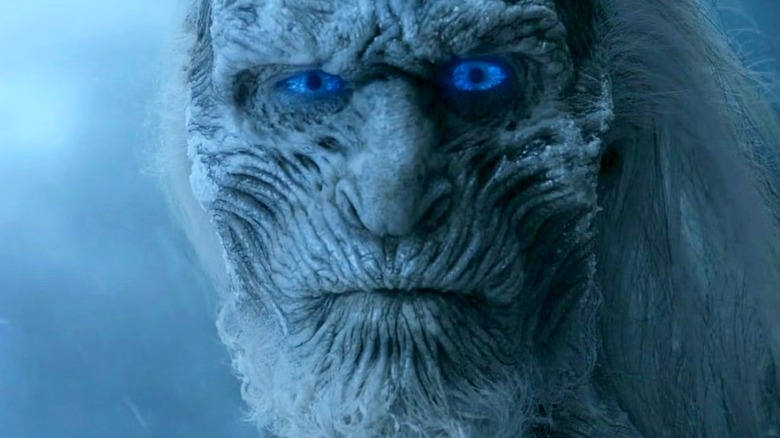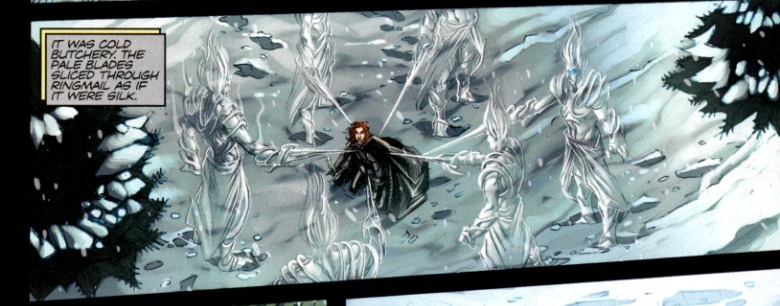With creator George R. R. Martin’s fantasy saga “A Tune of Ice and Hearth” at present (and maybe endlessly) unfinished, many mysteries stay unanswered. The TV adaptation “Recreation of Thrones,” which deviated from the supply materials even earlier than operating out of it, can solely fill in so many blanks.
Many questions burning brightest in my thoughts are concerning the Others: the ethereal ice beings that prowl past the Night time Watch’s Wall with a military of the undead at their management. The Others are supposedly the principle villains of those books, however 5 tomes in, and so they nonetheless really feel like they’re on the periphery of the story. Extraordinarily little has been revealed concerning the Others — their historical past, their tradition, their targets, and so on. Most of the most derided components of the “Recreation of Thrones” ending come all the way down to the way it failed to provide satisfying solutions concerning the Others.
The sequence expanded on obscure hints within the books that the Others is likely to be reworked people. In keeping with “Recreation of Thrones,” the Others had been first created way back by the Kids of the Forest, the wooden nymphs that lived in Westeros earlier than the First Males got here. As mankind tore down their wood properties to make approach for theirs, the Kids created a protection power and misplaced management of it. Is that this what Martin had in thoughts, or an invention of sequence creators David Benioff and D.B. Weiss? We could by no means know. (Although extra observant readers have leaped on a passage from “A Storm of Swords” describing an Different as “some kid’s snow knight.”)
“Recreation of Thrones” additionally offers the Others a pacesetter: the Night time King, an invention of the present unlikely to seem within the books given Martin’s disinterest in any “darkish lord” characters. Even their identify is modified, from “Different” to “White Walker.” The previous is extra generic but additionally extra mysterious. It means that these ice fiends are so completely inhuman they will solely be known as “Different.” “White Walker” is extra evocative and distinct, but it surely displays the present’s angle of treating the Others as simply snow zombies. The supply materials suggests they need to look much less like orcs, trolls, or demons, and extra like elves or fairies.
How the White Walkers are described within the Recreation Of Thrones books
The White Walkers in “Recreation Of Thrones” (and by extension, “Home of the Dragon”) have blue flesh with frostbite, shriveled like a mummy’s. This and the Walkers’ collapsed rib cages recommend they’re as undead because the Wights they command. After they begin sporting armor, it is black plated leather-based that would not look misplaced on a residing man.
Examine this with how the Others are described within the books. Within the prologue of “A Recreation Of Thrones” three unlucky souls meet the Others. First they sense them, “pale shapes gliding via the wooden” and “a white shadow within the darkness.” Then they arrive nose to nose with their hunter:
“Tall, it was, and gaunt and onerous as outdated bones, with flesh pale as milk. Its armor appeared to alter coloration because it moved; right here it was white as new-fallen snow, there black as shadow, in all places dappled with the deep gray-green of the timber. The patterns ran like moonlight on water with each step it took […] its eyes; blue, deeper and bluer than any human eyes, a blue that burned like ice.”
This description is much extra ethereal than the TV sequence; the Others are portrayed not as an limitless, ravenous horde, however sinister near-invisible shadows. Their armor evokes how ice naturally displays gentle, taking up the colour palette of what seems earlier than it. The White Walkers are silent minus an occasional screech, however the Others are heard to talk a tongue that to human ears appears like crackling ice. This, plus their armor and weapons carved from ice, underlines them as different – one thing so completely different from how we stay that we won’t perceive it. For us, ice represents dying. To those Others, it’s life.
The Recreation of Thrones comics have a unique White Walker design
Naturally, Martin’s description is troublesome to depict in a visible medium. The following neatest thing to your creativeness is how the Others are drawn within the “A Recreation of Thrones” comedian e book by artist Tommy Patterson. These Others had been designed with the enter of Martin, who described his imaginative and prescient for the creatures as such:
“The Others usually are not useless. They’re unusual, lovely … suppose, oh … the Sidhe [Gaelic fairies] fabricated from ice, one thing like that … a unique form of life … inhuman, elegant, harmful.”
The outcomes are extra ghostly than the live-action White Walkers. Colorist Ivan Nunes makes the Others look virtually intangible and translucent, like wisps using on the winds of winter.
As Patterson paperwork within the back-up pages of “A Recreation of Thrones” Quantity 1, the design went via a number of revisions and he struggled to excellent it. Then, Martin despatched him John Picacio’s drawing of the Others for the 2012 “A Tune of Ice and Hearth” calendar (reprinted within the comedian commerce paperback).
For an additional canonical depiction of the Others, here is how artist Marc Simonetti depicts them (printed within the 2014 information e book “The World of Ice and Hearth”). These Others look much less ethereal than Patterson’s within the comedian, but additionally extra preserved and fairly than the White Walkers.
I am going to additionally highlight some fan artwork depictions of the Others that I feel seize the “elegant [but] harmful” look Martin meant.
Most characters on the planet of Westeros usually are not pure good or evil; Martin stresses again and again in his writing how persons are advanced creatures, with usually contradictory good and dangerous halves. He additionally typically avoids the fantasy literature pitfall of creating the nice guys look heroic and the villains demonic. In “A Tune of Ice and Hearth,” evil can put on a face as comely as Cersei Lannister’s.
Martin even applies this to the story’s inhuman ice monsters. The phrase that involves my thoughts together with his description of the Others is “uncanny” — when one thing is acquainted, but not fairly proper. This makes it each creepy and alluring; you sense hazard however cannot look away. The White Walkers, although, are so clearly repellant and ugly that anybody of their proper thoughts would run from them with no second look.
Making the Others look scary, not mysterious, is only one case of the present not fairly capturing the books’ complexity.







